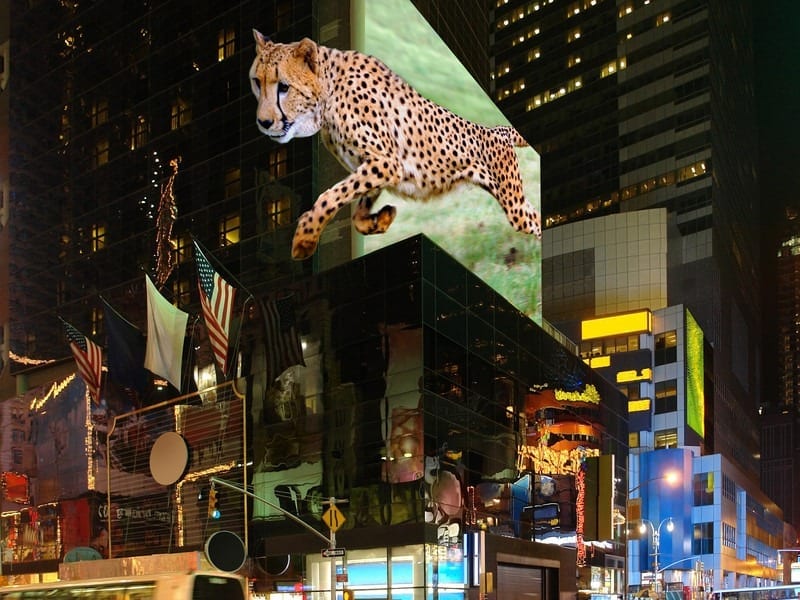
A new invention opens the door to a new generation of outdoor displays. Different pictures can be seen at different angles, creating 3D effects without the need for 3D glasses
Public screenings have become an important part of major sports events. In the future, we will be able to enjoy them in 3D, thanks to a new invention from Austrian scientists. A sophisticated laser system sends laser beams into different directions. Therefore, different pictures are visible from different angles. The angular resolution is so fine that the left eye is presented a different picture than the right one, creating a 3D effect.
In 2013, the young start-up company TriLite Technologies had the idea to develop this new kind of display, which sends beams of light directly to the viewers’ eyes. The highly interdisciplinary project was carried out together with the Vienna University of Technology.
A Start-up Company and a University
Together, TriLite and TU Vienna have created the first prototype. Currently it only has a modest resolution of five pixels by three, but it clearly shows that the system works. “We are creating a second prototype, which will display colour pictures with a higher resolution. But the crucial point is that the individual laser pixels work. Scaling it up to a display with many pixels is not a problem”, says Jörg Reitterer (TriLite Technologies and PhD-student in the team of Professor Ulrich Schmid at the Vienna University of Technology).
Every single 3D-Pixel (also called “Trixel”) consists of lasers and a moveable mirror. “The mirror directs the laser beams across the field of vision, from left to right. During that movement the laser intensity is modulated so that different laser flashes are sent into different directions”, says Ulrich Schmid. To experience the 3D effect, the viewer must be positioned in a certain distance range from the screen. If the distance is too large, both eyes receive the same image and only a normal 2D picture can be seen. The range in which the 3D effect can be experienced can be tuned according to the local requirements.
Hundreds of Images at Once
3D movies in the cinema only show two different pictures – one for each eye. The newly developed display, however, can present hundreds of pictures. Walking by the display, one can get a view of the displayed object from different sides, just like passing a real object. For this, however, a new video format is required, which has already been developed by the researchers. “Today’s 3D cinema movies can be converted into our 3D format, but we expect that new footage will be created especially for our displays – perhaps with a much larger number of cameras”, says Franz Fiedler, CTO of TriLite Technologies.
Read more: Huge 3D Displays without 3D Glasses
The Latest on: 3D Displays
[google_news title=”” keyword=”3D Displays” num_posts=”10″ blurb_length=”0″ show_thumb=”left”]
via Google News
The Latest on: 3D Displays
- Mapping the Milky Way's magnetic field in 3Don April 27, 2024 at 10:51 am
We are all very familiar with the concept of the Earth's magnetic field. It turns out that most objects in space have magnetic fields but it's quite tricky to measure them. Astronomers have developed ...
- Swave Photonics develops true holographic display for spatial computingon April 25, 2024 at 1:00 pm
Swave Photonics, a "true holographic display" company, announced the world’s first 3D holographic display technology for XR.
- Swave Photonics debuts Holographic eXtended Reality display with tiny-pixel technologyon April 25, 2024 at 6:00 am
Holographic display startup Swave Photonics today announced the development of what is claimed to be the world’s first 3D holographic display technology for compact extended reality form factors such ...
- Ulysse Nardin Unveils $148,300 Freak S Nomad Watch In High-Tech 3Don April 24, 2024 at 1:05 pm
The new Ulysse Nardin Freak S Nomad boasts colors that recall the desert dunes and a high-tech movement that is devoid of hands, crown, dial and more.
- oOh!media unveils Perth's first 3D anamorphic displayon April 23, 2024 at 3:43 pm
D Anamorphic out-of-home has made its debut in Perth, with oOh!media launching at its Yagan Square site, with creative and innovation hub POLY partnering with Scitech for the inaugural campaign. ...
- Innolux to showcase GenAI 3D printing; Other versatile display solutionson April 22, 2024 at 8:29 pm
Innolux will showcase its Generative AI (GenAI) technologies at the 2024 Touch Taiwan, including a 3D printer with AI 3D imaging solutions and its "Chat-N-Go" AI Automated Guided Vehicle (AGV) display ...
- How to turn off Google Maps 3D buildings on Android Auto and CarPlayon April 20, 2024 at 9:15 am
Google Maps on Android Auto and CarPlay now features the ability to show 3D buildings and it's on by default, but here's how to turn it off.
- The redesigned 3D printer from Formlabs gets us one step closer to the Enterprise Replicatoron April 17, 2024 at 6:23 am
The Form 4 is modular, more precise, and five times faster than the previous generation. The Form 4 3D printer is modular, more precise, and five times faster than the previous generation.
- Firearms cheaply made on 3D printers, guns pouring into NJ from Pa; lawmakers seek solutionson April 16, 2024 at 3:17 pm
Lawmakers in New Jersey say something needs to be done about illegal guns in the Garden State. Many of the guns are being printed at home on 3D printers, while others are flowing from Pennsylvania.
- Google Maps for Android now syncs 3D building settings with Android Autoon April 16, 2024 at 9:20 am
Google Maps is now able to sync your preference for showing 3D buildings between its apps on Android and Android Auto.
via Bing News










